- Home
- Tennessee Williams
The Traveling Companion & Other Plays Page 2
The Traveling Companion & Other Plays Read online
Page 2
Williams may not have been directly familiar with Artaud’s work, though it is likely he encountered Artaud’s theories during his studies at the New School for Social Research in New York City in the 1940s, and he certainly knew Genet’s work. In fact, in a 1960 essay in New York Magazine, Williams cited Camus, Genet, Brecht, Beckett, Anouilh, Ionesco, Durrenmatt, and Albee as his “fellow defendants” in writing honestly about life. The ending of Kirche, Küche, Kinder is unmistakenly Brechtian, as the Man “crosses right through that fourth ‘invisible’ wall” to exit through the theater, and the Wife directly addresses the audience, leaving it to “ponder those questions” that she poses “for a while. . . .” Kirche, Küche, Kinder contains moments remarkably similar to Artaud and Genet’s work as well. For example, a scene in the play, where the Minister throws a paper bag over the character Hotsy’s head, “plops a huge Bible under [her] derriere and mounts her [as] members of the press” burst in, is reminiscent of the same dismissal of good taste in Count Cenci’s violent pursuit of his daughter as he seeks to rape her in Artaud’s The Cenci (1935), an adaptation of the texts by Shelley and Stendhal. There are similar scenes of brutal rape and incest in The Remarkable Rooming-House of Mme. Le Monde, where “a delicate little man with a childlike face” named Mint, whose “legs are mysteriously paralyzed,” is repeatedly raped by his landlady’s son, a “muscular” boy “hung like a dray horse” who is “kept on the place for . . . incestuous relations with the lady.” In Williams’s THIS IS (An Entertainment) (1976), the role-playing of the Count and Countess that opens the play is strikingly similar to Genet’s The Maids (1947), and the invasion of the hotel by the mob outside, with the Countess’s lover, General Eros, leading the way, echoes the ending of Genet’s The Balcony (1956), as does the ending of The Pronoun ‘I,’ wherein a young revolutionary steals into the Queen’s chamber to assassinate her as the revolution escalates.
Many of Williams’s later plays in this volume focus less on elaborate language and character psychology, and more on the physical and visual aspects of theater, which was in keeping with the new dramatic styles in the theater that emerged during the 1960s. These included not only the work done by Samuel Beckett, Harold Pinter, and Edward Albee, for example, that was often influenced by the theories of Artaud and Bertolt Brecht, but also avant-garde theater troupes such as The Living Theatre, The Open Theatre, The Ridiculous Theatrical Company, and the Performance Group, which all did away with realism—the style that had dominated the American theater in the 1940s and 50s—and experimented with theater conventions from all over the world. In fact, in 1959 Williams went to Japan to visit the writer Yukio Mishima and was introduced to Kabuki theater, which very much influenced his later work. Williams had first met Mishima in 1957, and dedicated The Day on Which a Man Dies to him. The earliest complete version, published here, was begun in 1957, and is dated in Williams’s handwriting as finished in 1960. The Day on Which a Man Dies, The Milk Train Doesn’t Stop Here Anymore, and even The Night of the Iguana and I Can’t Imagine Tomorrow all exhibit the influences of Japanese Kabuki and Noh theater—a style of theater initiated in the fourteenth-century that combines dance, music, and story-telling. Mishima wrote a series of modern Noh plays that were published in English in 1957, and two years later New Directions published Ezra Pound and Ernest Fenollosa’s The Noh Theatre of Japan. It is this spelling of “Noh,” rather than the equally common spelling “Nō,” that Williams uses. As director David Kaplan notes, Williams seems to also have been aware of the Japanese art movement known as Gutai, since The Day on Which a Man Dies appropriates aspects of Gutai performance art, particularly the death of the painter and the eccentric means by which paintings are created and destroyed on stage.
These later plays were often anti-realistic in their treatment of language, character, and action. Like Japanese Noh and the avant-garde European plays of the time, meaning is found not through language, but in the pauses and silences, in what is not said. Instead of the long, poetic passages for which he had become famous, Williams’s later plays often contain truncated and unfinished sentences. In The Two-Character Play, for example, the broken dialogue exists mostly for diversion, as in the plays of Samuel Beckett, to subdue the characters’ sense of panic, and the play expresses a contemporary sense of dread. Instead of characters with elaborate psychological and social backgrounds in the style of realism, the characters are generically named “One” and “Two” (I Can’t Imagine Tomorrow), “Boy” and “Girl” (Green Eyes), or “Man” and “Woman” (The Day on Which a Man Dies). Instead of conventional plot development, themes are explored, often along with a collage of images. For example, a later draft of The Day on Which a Man Dies ends with an explosion of political and cultural images, much in the style of the artist Robert Rauschenberg.
Throughout his career, Williams was aware of evolving contemporary art and culture, and his own style changed with the times and reflected these new developments. Yet critics did not know how to evaluate these later works of Williams, and so they often judged them via the standards of realistic theater, dismissing them as failures and complaining, for instance, that Williams’s characters weren’t well-developed and that they didn’t finish their sentences, which of course misses the entire significance of theater that challenges realistic conventions. In the same way abstract painting by artists such as Pablo Picasso or Jackson Pollock (whose acquaintance with Williams dates back to 1940) challenges realistic painting that reproduces what an object looks like on the surface—a bowl of fruit or a landscape, for instance—Williams’s later plays often eschew realistic representation in order to access those truths beyond reality’s surface.
Williams’s exploration of freer dramatic forms later in his career was a direct reaction to changes in society, in the theater, in television and popular culture, and in his personal views of life. He continued to write about the cruelty of the world as he did in the earlier plays, but he depicted this cruelty more graphically and literally, rather than veiling it in symbolism. He admitted in 1975 that his work had become “darker” and that “people find it painful.” Politically and socially, American society was changing, and Williams’s late plays respond to and address these issues. His plays were becoming more directly political and more overt in terms of sexuality in general, and homosexuality in particular. In the 1960s and 70s there was no longer a need to downplay homosexual themes as subtext or subplot, as Williams had done in The Glass Menagerie, A Streetcar Named Desire, or Cat on a Hot Tin Roof, for example. In 1968, laws forbidding the depiction of “sex perversion” in the theater, including homosexuality as it was classified at the time, were repealed in the United States (and similar laws were repealed in Britain), allowing for greater freedom in the theater. In 1969, the “Stonewall rebellion” in New York City—in which gay and transgendered patrons of the Stonewall Inn on Christopher Street fought back against police oppression—brought attention to gay rights, and marked a watershed moment for social and political recognition, sparking the national Gay Liberation Movement. The new freedoms that American society increasingly embraced also led Williams to finally come out publicly as a gay man on national television in 1970, which he could not have done safely, either professionally or personally, in 1950.
On an even larger political scale, the Vietnam War had absorbed the nation by the late 1960s, and by the 1970s America was also struggling with difficult economic times and tumultuous social revolutions: Gay Liberation, the Women’s Liberation Movement, the Black Power and Civil Rights Movements, as well as race riots throughout major U.S. cities. With the threat of nuclear war still looming during the 1980s, Williams’s plays often focused on the national paranoia fused with his own personal paranoia. The Chalky White Substance, written in 1980, is set in a post-apocalyptic world where there is little human tenderness, and the earth is covered with a mysterious chalky white powder that continually blows through the sky and envelopes everything and everyone. Although the names of the two
characters, Luke and Mark, evoke the Apostles, they live in a post-apocalyptic wasteland where cruelty and survival of the fittest dominate. In The Remarkable Rooming-House of Mme. Le Monde, which was written in the early 1980s (probably completed in 1982), Mme. Le Monde has “a fiery red mop of hair that suggests a nuclear explosion, as does her voice.” In A House Not Meant to Stand (1982), the collapsing house serves as a metaphor for a disintegrating society, which the father of the family, Cornelius, describes as imminently threatened by nuclear devastation. In both The Chalky White Substance and The Remarkable Rooming-House of Mme. Le Monde, a world of instability and meager resources is marked by the cruelty and ruthlessness of individuals in their fight for self-preservation.
The themes of fundamental human selfishness and the predatory aspect of nature that appeared in plays such as Suddenly Last Summer, The Gnädiges Fräulein, and Kingdom of Earth, for example, are intrinsic to the later plays published here, particularly The Chalky White Substance, The Remarkable Rooming-House of Mme. Le Monde, Kirche, Küche, Kinder, and even The Traveling Companion. In The Chalky White Substance, Luke’s “protector,” Mark, threatens to turn him in to the authorities in order to claim the reward for cooperating with a totalitarian regime. Mark claims that he is capable of such action to save himself, since self-preservation has become the way in a world which “can’t support its shrinking population . . . a man will use a woman a while and then, when she’s no longer desirable to him, not as she was before, he’s likely to destroy her.” In The Remarkable Rooming-House of Mme. Le Monde, natural law dominates and the characters are reduced to their bestial origins, as Mint can now “get about only by swinging from hook to hook, like that historical ape man swinging from branch to branch in the jungle.” Mint is used for violent sexual gratification throughout the play: raped, neglected, mocked, and starved. Mme. Le Monde distributes meager rations for Mint’s consumption, and eventually these disappear as Hall greedily devours the tea and biscuits without regard for Mint’s suffering, even as Mint begs him to “Have pity on a broken and desperate soul, subsisting on diminishing bits of—charities. . . .” In Kirche, Küche, Kinder, the Wife preempts any request of hospitality from her father, the Lutheran Minister, saying that she would like to offer him some coffee and crullers, but “I got to preserve it all for myself.”
This sort of desperate self-concern is described by Williams in both Kirche, Küche, Kinder and The Traveling Companion as the “give-me’s.” In Kirche, Küche, Kinder the Wife suspects that her father has thrown her mother off the Staten Island Ferry because “Mama, she had the gimme’s, huh Papa? And in dis world, die gimmes ain’t often die getters.” And in The Traveling Companion Vieux proclaims that “New traveling companions reflect the indifferent times we live in, neglect everything but themselves and their own concerns. Got the ‘give-me’s.’ Give me, give me, give me. But the give-me’s don’t always get. Unquestionably there is some intellectual as well as moral delinquency in your new type of traveling companion.”
The withholding of comfort and sustenance in these Williams plays is also strongly reminiscent of Beckett’s work, particularly Endgame (1958), and both playwrights depict a world of frustration, degeneration, decay, and lack, coupled with the cruelty of self-preservation. The sadistic hoarding of resources in The Remarkable Rooming-House of Mme. Le Monde and Kirche, Küche, Kinder, for example, can be compared to Hamm’s cruel manipulations in Endgame, as he uses the promise of food and its withholding to get what he wants. He keeps his parents, Nagg and Nell, in ashbins like animals, and agrees to give Nagg a sugarplum only if he will listen to his story, exhibiting a generosity based primarily on a system of exchange. When Nagg requests his payment, however, Hamm replies that “There are no more sugarplums!” Similarly, Clov keeps Hamm from his “painkillers,” stating that there are “no more painkillers.” When Hamm threatens Clov with starvation if he does not serve him efficiently, Clov replies that he will therefore die. Hamm’s retort is the ultimate cruelty, prolonging suffering and denying satisfaction: “I’ll give you just enough to keep you from dying. You’ll be hungry all the time.”
This sense of frustration can be seen from the beginning of Endgame in the stage tableau, described with “two small windows” set so high up that Clov needs to climb a ladder to look out of them. In Kirche, Küche, Kinder, the Man’s description of his room is strikingly similar: “Soon the room, this box square as a block, containing a single window, set so high in the wall that it could only be reached by a wall-painter on a ladder. . . .” The frustration that opens Endgame moves to a sense of degeneration that is evident throughout the play, as Hamm has lost both his eyesight and the use of his legs, while Nell complains to Nagg that they “don’t laugh anymore,” and Clov laments the fact that beauty inevitably wanes: “We too were bonny—once. It’s a rare thing not to have been bonny—once.” This Beckettian sense of loss and decay weighed heavily on Williams’s mind when writing The Remarkable Rooming-House of Mme. Le Monde. Like Hamm, Mint’s legs are “mysteriously paralyzed,” and his misery appalling, as he must use his hands to swing from metal hooks set high above, often just out of his reach. In an earlier draft of the play titled A Rectangle With Hooks, there is another exchange reminiscent of Beckett that was cut from the final version: when Mint asks if the tea is still warm, Hall replies that “It has a faint recollection of having been warm once.”
Yet survival in the face of ultimate decay—“going on”—is inevitable for both Williams’s and Beckett’s characters, who persevere until they no longer can. In both Kirche, Küche, Kinder and Beckett’s narrative trilogy—the three novels Molloy, Malone Dies, The Unnamable (1955, 1956, 1958)—desire stubbornly remains in a perversely comic guise well after youth and beauty wane. In Kirche, Küche, Kinder, a decrepit ninety-nine-year-old woman is not only presented as grotesquely sexual, but she is also pregnant. Similarly in Malone Dies, Malone narrates the “love affair” between Moll, an ancient, foul-smelling, decaying woman, and Macmann, whose “desire to take her, all stinking, yellow, bald and vomiting, in his arms” is not at all diminished by her degenerated state. Beckett’s famous ending to his trilogy, the acknowledgment that “you must go on, I can’t go on, I’ll go on,” echoes Williams’s famous battle-cry—“En Avant!”— which appears throughout his letters, journals, and interviews.
Williams’s suspicions about human motives and his loss of faith in good will may have been natural in a world threatened by economic crises and nuclear catastrophes, but he was, after all, also now viewing life through a different lens, as an older man. Yet his characters in these later plays are not simply jaded; they are decidedly stronger. His heroines are no longer defeated by life and left at the mercy of a cruel world—Williams said there would be “no more Southern belles” in his later work. These women survive on their own terms and are no longer victims. Both The One Exception and Sunburst are marked by moments of tragicomic dark humor and the stubborn strength of survival that characterizes the later plays. The One Exception, dated by Williams as January 1983, is apparently the last play that Williams completed before his death a month later. The play’s main characters, Kyra and Viola, are both artists who cling to creative work for meaning, but Kyra has lost touch with the most recent artistic trends and fears the isolation that awaits her, while Viola approaches her in her moment of crisis only to secure a loan to promote her own career. Institutional confinement, loneliness, and the un-kindness of predatory “friends” were fears that plagued Williams throughout his life. Kyra and Viola symbolize his internal struggle for survival and his insistence on always moving forward, as he, like Kyra, faced a “Paralysis of—decision.” While the play recalls both the final scene of A Streetcar Named Desire and Williams’s own three-month confinement to the psychiatric ward of Barnes Hospital in St. Louis in 1969, it most directly echoes the institutionalization of his sister Rose, with its looming threat of “The Lodge”— a likely reference to Stony Lodge in upstate New York where Rose s
pent much of her life. Kyra’s outcome, however, is less certain than Rose’s, and a possibility of survival remains at the end.
In Sunburst, Miss Sails, “a lady of somewhat advanced years” who is “in retirement from a long career as an actress,” foils the plot of two scheming young men who want to steal her priceless sunburst diamond. Sunburst was probably completed sometime between 1978 and 1980 (cultural references that belong to the late 1970s, such as the thinly disguised Club 54 and the popularity of cocaine use, support that dating of the play). The play’s humor surfaces as Luigi and Giuseppe try to manipulate and subdue Miss Sails, who resists her captors by stalling them and even by reciting quotations from Shakespeare. Like Miss Sails, Williams’s later characters find the strength to survive on their own terms and mirror Williams’s own struggle in his later years. In The Pronoun ‘I,’ Mad Queen May, a young woman masquerading as old, fools her pursuers and escapes, through secret stairs and underground passageways, the revolution raging outside, while she has her young lover, who tried to betray her, captured before he gets away—so the “old Queen” wins. Similarly, in The Traveling Companion, Vieux, the older writer who is accompanied by Beau, the lovely young man he met in a gay bar, takes control of the situation and refuses to be conned by Beau. And in Will Mr. Merriwether Return from Memphis? the aging Southern belle, Louise, waits on the front porch for her lover, Mr. Merriwether, who has promised to return for her, and he does return.
Will Mr. Merriwether Return from Memphis? is a fantasy with a quasi-realistic structure, as the plot is interrupted with visits from historical apparitions, some of whom have gone mad, such as Vincent Van Gogh. Louise resigns herself to waiting for her lover, claiming that “There’s nothing to do but wait, with fox-teeth in the heart.” We see this reference to “fox-teeth in the heart” again in The Traveling Companion (“Cypress woods are demon dark—boys are fox-teeth in the heart”) as well as in Williams’s novel Moise and the World of Reason (1975), and in his poem “Winter Smoke is Blue and Bitter,” which also contains nearly the same line. The looming madness of frustrated desire—“fox-teeth in the heart”—is a theme repeated in both A Cavalier for Milady and The Parade, along with the mysteries of desire‚ a topic that occupied Williams until the day he died. In A Cavalier for Milady, as in Will Mr. Merriwether Return from Memphis?, an apparition is conjured to ward off loneliness, and in The Parade Don questions the very nature of desire, asking “What makes desire? Desire for a face or a body? Why does flesh in certain forms become an obsession with you? Why does it darken your mind?” The Parade was begun in Provincetown in the summer of 1940, where Williams fell in love with a dancer named Kip Kiernan, who ultimately disappointed him. The play, based on the events of that summer, was revised and finished in 1962, and submitted to his publisher in 1979 in a collection of odds and ends titled Pieces of My Youth. Don explains his obsession with the object of his desire as fulfilling “an erotic image which must have been lurking secretly in some closet in my mind.” The events that led Williams to write The Parade are revisited with a different focus in his later play, Something Cloudy, Something Clear, which is seen through the shifting perceptions of both the younger and the older Williams as a writer struggling to reconcile the past and the present.

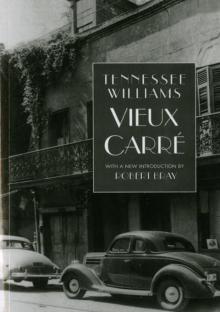 Vieux Carre
Vieux Carre The Night of the Iguana
The Night of the Iguana A Lovely Sunday for Creve Coeur
A Lovely Sunday for Creve Coeur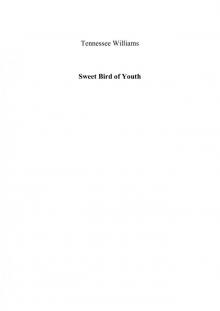 Sweet Bird of Youth
Sweet Bird of Youth Streetcar Named Desire
Streetcar Named Desire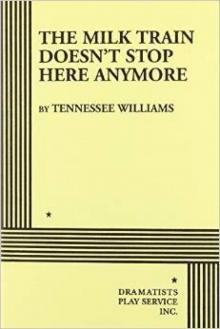 The Milk Train Doesn't Stop Here Anymore
The Milk Train Doesn't Stop Here Anymore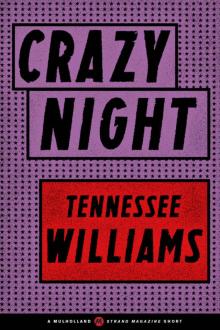 Crazy Night
Crazy Night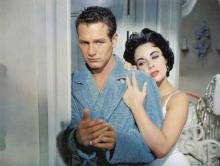 Three Plays of Tennessee Williams
Three Plays of Tennessee Williams A House Not Meant to Stand
A House Not Meant to Stand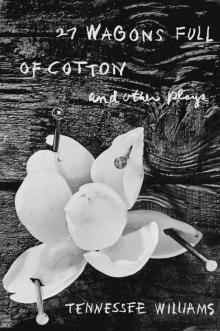 27 Wagons Full of Cotton and Other Plays
27 Wagons Full of Cotton and Other Plays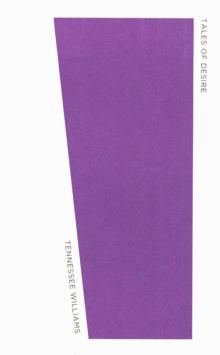 Tales of Desire
Tales of Desire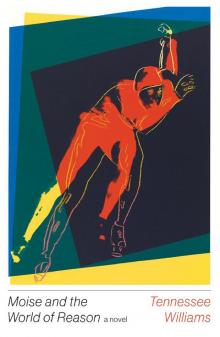 Moise and the World of Reason
Moise and the World of Reason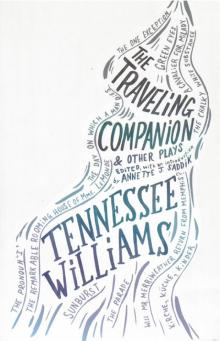 The Traveling Companion & Other Plays
The Traveling Companion & Other Plays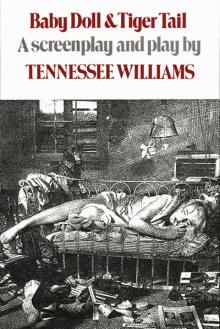 Baby Doll Tiger Tail: A Screenplay and Play by Tennessee Williams
Baby Doll Tiger Tail: A Screenplay and Play by Tennessee Williams Memoirs
Memoirs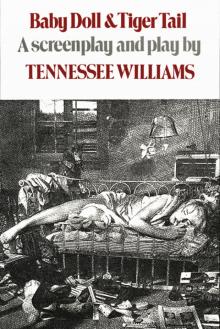 Baby Doll & Tiger Tail
Baby Doll & Tiger Tail Crazy Night (A Mulholland / Strand Magazine Short)
Crazy Night (A Mulholland / Strand Magazine Short)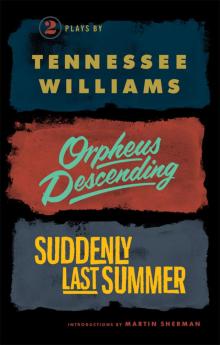 Orpheus Descending and Suddenly Last Summer
Orpheus Descending and Suddenly Last Summer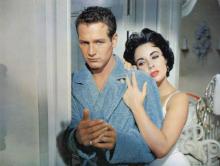 Three Plays
Three Plays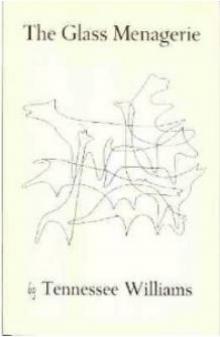 The Glass Menagerie
The Glass Menagerie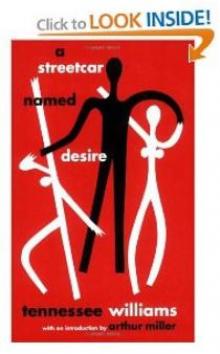 A Streetcar Named Desire
A Streetcar Named Desire